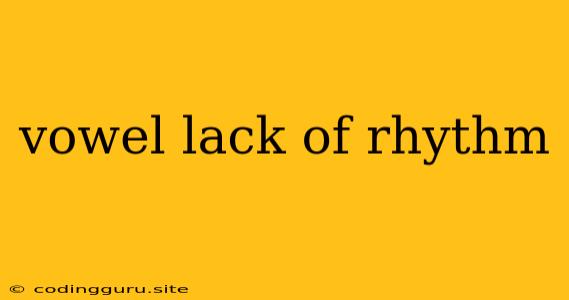The Impact of Vowel Reduction and Lack of Rhythm on Language Understanding
The human voice is a complex instrument, capable of producing a vast array of sounds. These sounds are essential for communication, allowing us to convey thoughts, emotions, and ideas. One key aspect of this complex process is the role of vowels. Vowels are the building blocks of language, providing the basic sounds that shape words and sentences. However, their role goes beyond simply being the foundation of spoken language.
What is vowel reduction?
Vowel reduction is a common phenomenon in many languages where vowels in unstressed syllables become less distinct. This means that the sound of the vowel changes, often becoming shorter or more similar to another vowel. For example, in English, the vowel in the word "about" is typically reduced to a schwa sound (/ə/) when spoken quickly or casually.
How does vowel reduction affect rhythm?
Vowel reduction can have a significant impact on the rhythm of a language. When vowels are reduced, they become less prominent, and this can lead to a more monotonous rhythm. This is particularly true in languages like English, where the stress pattern of words and sentences is crucial for understanding.
What is the lack of rhythm?
The lack of rhythm can be defined as the absence of a discernible pattern in the timing of sounds. This can result in speech that is difficult to follow and understand. While some languages may have a more relaxed or less pronounced rhythm, the absence of any rhythm can make speech challenging to comprehend.
How can a lack of rhythm affect understanding?
Imagine listening to someone speak where the timing and emphasis of each word are inconsistent and unpredictable. This lack of rhythm can make it difficult to group words into meaningful phrases, and ultimately, to understand the speaker's message.
What are the implications of vowel reduction and a lack of rhythm?
The combination of vowel reduction and lack of rhythm can pose significant challenges for language learners. Understanding spoken language requires recognizing both the individual sounds and the patterns in which they occur. When vowels are reduced and the rhythm is unclear, the task of deciphering speech becomes significantly harder.
Can these factors affect language development?
For children learning their native language, vowel reduction and lack of rhythm can hinder their acquisition of the language's specific sound patterns. This can lead to difficulties in pronunciation and understanding the complexities of their language.
What are some tips for improving rhythm and vowel clarity?
- Focus on the stressed syllables: When speaking, pay attention to the stressed syllables in each word. This will help to create a more distinct rhythm and make your speech clearer.
- Practice speaking with a clear voice: Avoid mumbling or slurring your words. Make a conscious effort to articulate each sound, including the vowels.
- Listen to native speakers: By listening to native speakers, you can pick up on the natural rhythms and vowel sounds of the language.
- Record yourself speaking: This can be a helpful tool for identifying areas where you need to improve your pronunciation and rhythm.
What are the potential solutions to address these challenges?
For language learners, the key to overcoming the challenges of vowel reduction and lack of rhythm lies in increased exposure to the language and practice. By actively engaging with spoken language, learners can become more attuned to the subtle nuances of pronunciation and rhythm.
Is there a connection between vowel reduction and accent?
Yes, vowel reduction is often a characteristic of different accents. For example, in certain English accents, the vowel in words like "about" or "ago" is often reduced to a schwa sound. This is a natural part of the way people speak, and it does not necessarily mean that their pronunciation is incorrect.
How can we better understand these aspects of language?
Further research is needed to fully understand the relationship between vowel reduction, rhythm, and language understanding. Studying these factors across different languages and dialects can shed light on the complex mechanisms of speech perception and production.
Conclusion:
Vowel reduction and lack of rhythm are two interconnected aspects of spoken language that can significantly impact communication and understanding. By understanding these phenomena and developing strategies for addressing them, we can improve our ability to communicate effectively and appreciate the nuances of language. As language continues to evolve, it's essential to remain mindful of these factors and their role in shaping how we understand and experience the world around us.
